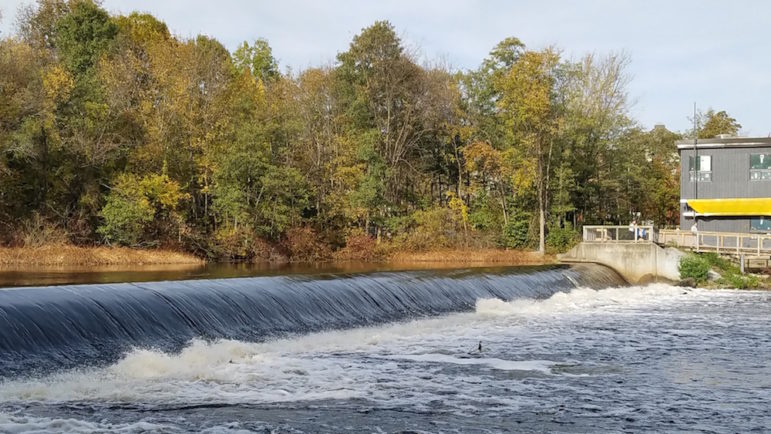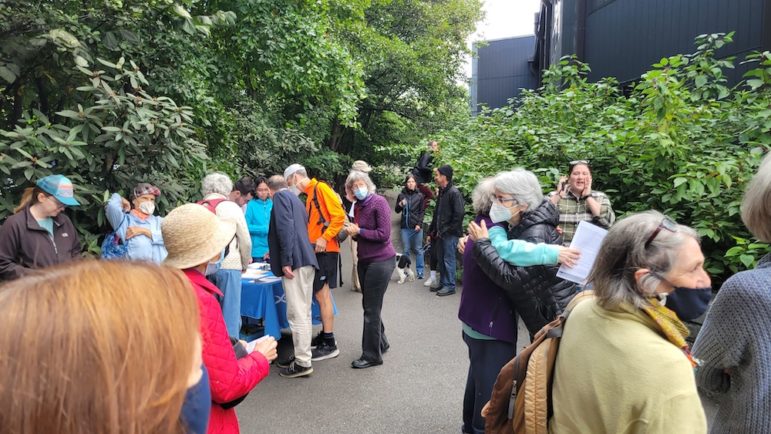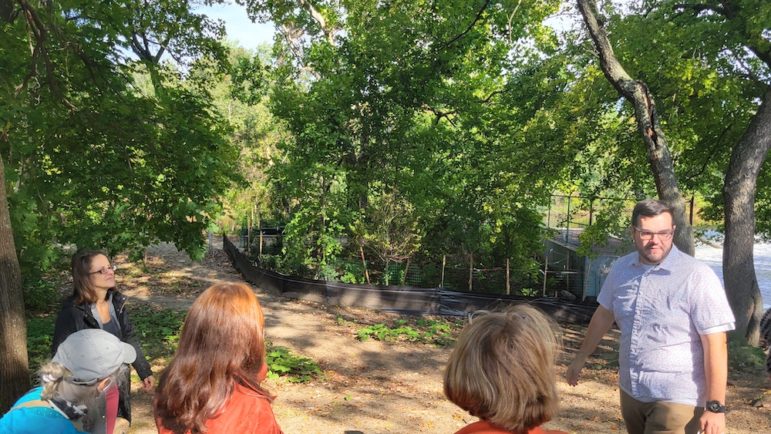
Charlie Breitrose The Watertown Dam near Watertown Square slows the flow of the Charles River. A group is advocating removing the dam.
Around 50 people showed up Saturday morning to hear about a proposal to remove the Watertown Dam, and restore the area to how it was before the first dam was put there in the 1600s.
The Charles River Watershed Association organized the tour, and the group is advocating for the dam to be removed to allow more fish and wildlife to travel up and down the Charles River, and also because it poses a risk of failure in a major storm, said CRWA Executive Director Emily Norton.
The first dam in the area of the current Watertown Dam was a grist mill built in 1634 by early colonists. A dam replacing the original one was built in 1814, which included a fishway to allow fish to migrate upstream to spawn. The current dam was built in 1955 after the older one was damaged by Hurricane Diane, and the current fish ladder was built in 1972, according to the Historical Society of Watertown. There were natural falls in the area prior to the first dam.
While the fish ladder, which is inside a concrete box on the south side of the dam, allows for some species to get upstream, other species of fish and other animals struggle or cannot get up the ladder, said Ben Gahagan, a diadromous fish biologist with the Massachusetts Division of Marine Fisheries.

Gahagan studied the types of fish going up the ladder using a camera put inside the fish ladder, and by tagging fish and seeing if they make it up stream.
“We observed 100s of herring (going up the fish ladder) and only 30 to 40 shad, and not the fat females,” Gahagan said.
He was asked whether putting in a better fish ladder would take care of the problem of fish spawning, but Gahagan said that with the best ones, “high 80s percent is the best case,” for species that can traverse the ladder. Some fish will try to come up the other side of the river, and do not make it. Other species of fish, such as smelt, cannot go up the fish ladder, nor can turtles and salamanders, Gahagan said.
Charlie Breitrose
A large crowd gathered by the Charles River on Oct. 2 to learn about the proposal to remove the Watertown Dam. 
Some on the tour said the pool of water behind the dam provides an area for birds and animals to live all year, because it rarely freezes over. They worried this would be lost.
The Watertown Dam has been classified as a Significant Hazard for failure, according to the Town of Watertown’s draft Hazard Mitigation Plan. This means a failure “may cause loss of life and damage to home(s), industrial or commercial facilities, secondary highway(s) or railroad(s), or cause the interruption of the use or service of relatively important facilities.”
While the main part of the dam is made of concrete, a portion along the south shore of the river near the fish ladder is made of earth. That area could be vulnerable during a major storm, with water washing over it, and potentially causing a failure, Norton said.
If the dam breached, the mitigation plan said, water could impact the Galen Street Bridge, and shut down roads along the river, such as the main Watertown Square intersection, Charles River Road and Nonantum Road. Facilities parks would have to be evacuated, including the Charles River Greenway with the Braille Trail, the Watertown and Newton yacht clubs, Daly Rink and Daly Field, and the Community Rowing boat house.
According to a CWRA feasibility study, “Watertown Dam has no functional purpose at this time. Although it could theoretically be used to supplement flood control measures downstream, the relatively small storage volume and lack of historical need make this use unnecessary.”
Many on the tour said they like the falls created by the Watertown Dam, and enjoy seeing the wildlife, including the large herons and other birds that gather to eat the fish.
Others were concerned about the sediment that has settled behind the dam because some of it is from the days when the Charles River was heavily industrialized by mills along the shore. If the dam is removed, the sediment would be tested, and pollutants would be dug out and trucked out to a disposal facility, a representative from the CWRA said.
Charlie Breitrose
The Charles River Watershed Association led a tour of the Watertown Dam to talk about a proposal to remove the structure. Executive Director Emily Norton, left, and Climate Resilience Specialist Robert Kearns spoke to the group, with the earthen part of the dam visible behind them. 
If the dam is removed, the river would return to free flowing stream, said Robert Kearns, Climate Resilience Specialist with the CWRA.
“There is a natural change of elevation,” Kearns said. “You will still have water gurgling over rocks. It will not be the same but it will still be pretty.”
People on the tour requested that a graphic representation be made to show what the river would look like if the dam was removed.
Norton pointed to an example of a similar project in Exeter, N.H., where the Great Dam was removed.
While the CWRA has been calling for the removal of the dam, they do not have control of the property. The Watertown Dam is owned by the Massachusetts Department of Conservation and Recreation (DCR).
Residents on the tour asked why the project should be done now. Norton said that she is hopeful the project could get some of the money earmarked for water infrastructure and climate resiliency from the federal ARPA (American Rescue Plan Act). She said the last time there were recovery funds after the economic downturn of the late 2000s, the projects that got approval were the ones that had solid plans in place.
The tour was just the start of the process, Norton said. More community meetings will be held, and opportunities to give feedback.
What a waist of resources to worry about the dam.
If the area of dam that is of question fails, it will not likely create much of an issue down stream as was overly dramatically emphasized.
It’s obvious to me that on one hand alarm bells are being raised to spend money on a pet project while also saying ” the relatively small storage volume” when referencing it’s flood control potential.
I say let it work out on it’s own over time. There is no significant flood damage that can occur if it “fails” at some time in the future based on the ” the relatively small storage volume”.
Turtles and other wild life are adapting to it just fine.
David, I have to disagree, heavier rainfall amounts like this year, and extreme weather are baked into the cake in terms of what we can expect to continue and in fact, increase due to climate change. If the dam fails, it will more than likely occur when it is stressed during extreme conditions, so to say the scenario envisioned is ‘overly dramatic’ is simply false. It will fail at the worst possible time. Dams, especially those that are aged and in danger of failing, are being removed across the state and have been for some time. You may not have been around at the time, but back in 2005 a dam in Taunton was the lead story on local and national news (CNN), and led to evacuations, look up the Whittenton Pond Dam.
note: waste/ ‘waist’
I would advocate for returning things to their natural state especially if they pose no danger. The earth was created to sustain itself. It is only man who has ruined that. Let the wildlife return. If we could only keep boats, bad technogy and oil slicks from ruining our oceans and planet…
Wish I could have attended this meeting and tour, but had other plans. I’m all for removing the dam to allow the river to return to a more natural state. Have to admit, I would miss the annual spectacle of feasting birds at the dam during the herring run in the spring, but I’m sure that there would still be many great natural spectacles if the river were restored to a more natural state. The concern about dam failure and flooding is quite frankly, terrifying! Since this dam has been in place since 1955, it is already aged. I haven’t heard any convincing arguments for keeping it in place any longer. Looking forward to more meetings on this topic in the future!
Thanks for your comment. The Watertown News policy for comments is they must be signed with your full name. Please feel free to resubmit the comment.
I am not sure about the consequences if the dam was to be removed.
Question 1. When there is an abundant amount of rain, keeping the dam, where does it go?
2. If the dam was to be removed, the water coming down stream has nothing to slow it down. It will just flow and flow abundantly without the dam. So what happens downstream? What will be effected by an abundant amount of water, at once with nothing to slow down the water.
3. What type of areas will be affected with an abundance of water.
Please do not kid yourself. The water has to go somewhere’s. This needs to be talked about and studied before the dam is taken down.
Now some of you say the water travels the same with or without the dam. I would ask for a study on this thought.